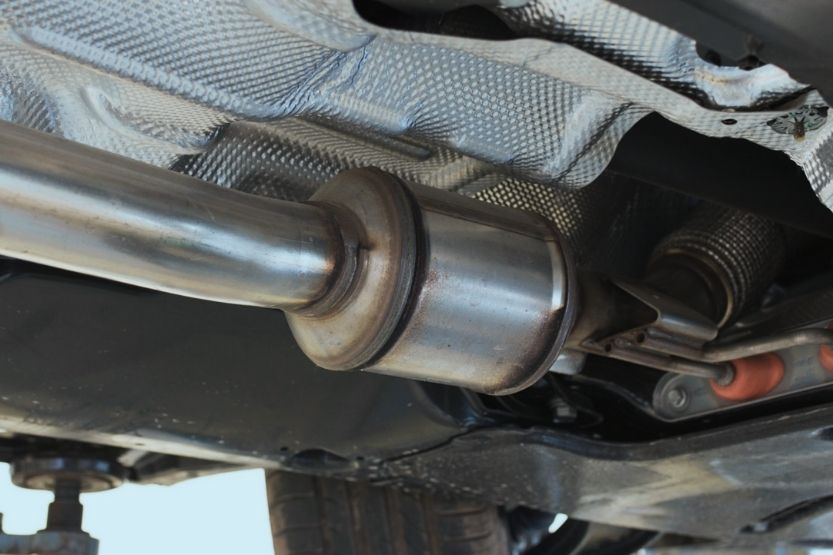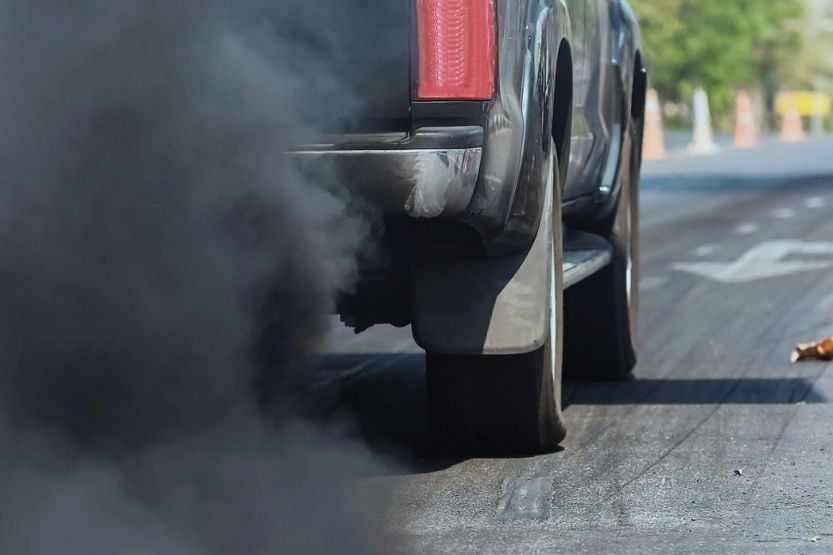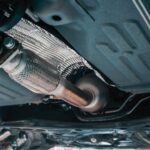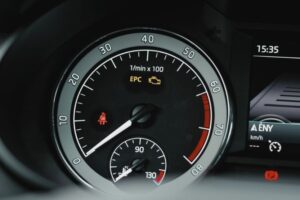The catalytic converter helps reduce airborne pollutants that may harm people and the environment. It also has a positive impact on the efficiency of vehicles. But can you drive without a catalytic converter?
Driving without a catalytic converter will generally not damage the engine or your car. But it is illegal to drive without it because it is essential in reducing airborne pollutants that are harmful to people and the environment. Also, your car will most likely fail an emissions test if it doesn’t have a catalytic converter.
Read on to learn more about the catalytic converter, including its purpose and features.
Can You Drive Without a Catalytic Converter?

In general, driving without a catalytic converter will not cause any damage to the engine or your car.
Illegal to Drive Without a Catalytic Converter
But it is illegal to drive without it because it is essential in reducing airborne pollutants that are harmful to people and the environment. Also, your car will most likely fail an emissions test if it doesn’t have a catalytic converter.
May Cause Severe Car Damage
Your car will run even without a catalytic converter. But while it may not cause any severe immediate damage to your vehicle, it will still have a negative impact, especially in the long run.
How Long Can You Drive Without a Catalytic Converter
If you drive your car without a catalytic converter, it will surely still be up and running. But can you drive one knowing that you are harming humans and the environment?
Besides, driving without it is against the law. So, if you are asking how long you can drive without it? You can drive your car until you get caught by the authorities.
What Is a Catalytic Converter
Emission Control Device Located in the Exhaust System
The catalytic converter refers to an emission control device located in the exhaust system. It was initially introduced in the 1970s until it eventually became a standard vehicle requirement.
Illegal to Remove, Change, or Vandalize a Catalytic Converter
In the United States, some laws strictly require the presence of this device in all vehicles. This means that it is illegal to drive your car without it. It is illegal to remove it, change it, or vandalize it following the law.
What Is the Purpose of a Catalytic Converter
Reduce Harmful Emissions in the Exhaust of Vehicles
The main purpose of the catalytic converter is to reduce harmful emissions in the exhaust of vehicles. This is to help lessen the pollution.
Catalysts
Catalysts are used to convert harmful chemicals into harmless substances. These include carbon monoxide, nitrogen oxides, and hydrocarbons. The catalysts may be composed of one of the following metals or a combination of all:
- Rhodium
- Palladium
- Platinum
There are, however, catalytic converter makers that have started to add gold to the mix. Gold is said to be less costly than other metals. Also, it is capable of better oxidizing some chemicals.
As far as catalytic converters are concerned, oxidation may mean “burning.” Catalysts heat to extremely high temperatures.
Converts Harmful Substances Into Non-toxic Materials
When these temperatures are combined with unique metal properties, they create a chemical change in unwanted and harmful substances. These harmful substances are then converted into harmless ones.
An example of this is the poisonous carbon monoxide that can be converted into carbon dioxide. Another example is the nitrogen oxides which can be split into nitrogen and oxygen. As for the hydrocarbons, they are converted into water and carbon dioxide.
What to Do If the Catalytic Converter Is Stolen
Surprisingly, catalytic converter theft is on the rise. If you become a victim of this, what should you do?
Do Not Drive Without a Catalytic Converter
Once you realize that your catalytic converter has been stolen, it is best not to drive it. It’s against the law to drive a car without it.
Also, you will only cause harm to humans and the environment. At the same time, your car will most likely produce extreme noise. It will also spew fumes both inside and outside the car. This means that you will harm your health too.
If your catalytic converter is stolen, the thieves will most likely not remove it with extra precaution. They will most likely use a blowtorch or a power saw and carelessly remove it. They don’t care if other parts of your car get damaged. In which case, it can affect your car’s driveability.
It is important to know, too, that your car’s comprehensive insurance can cover a stolen catalytic converter. So, it’s best to contact your insurance company immediately if this happens to you.
Why Do People Steal Catalytic Converters?
Thieves find it easier to steal catalytic converters. This is because it is conveniently placed under the vehicle towards the exhaust. They can cut the device in just a few minutes with the proper tools.
Sport utility vehicles (SUVs) are, unfortunately, more vulnerable due to their raised ground clearance. This makes it all more convenient for thieves. Also, SUVs or larger vehicles tend to have catalytic converters with more precious metals.
How to Protect Your Car from Catalytic Converter Theft?

It is hard to stop a professional thief. But you can take steps to convince a less determined one to steal your catalytic converter.
Some manufacturers offer shields or metal cages for catalytic converters. That way, it will be harder for thieves to steal it. You may want to get one for your catalytic converter.
It might be good to stamp your car’s Vehicle Identification Number (VIN) on the catalytic converter. It might still be possible to find it if it is sold to someone else. You also can track down the culprit.
Below are tips on how you can prevent thieves from stealing your car’s catalytic converter?
- Find a Good Parking Space
- Stamp a Serial Number on the Catalytic Converter
- Install Security Cameras
- Weld the Bolts Shut
- Install Alarms
Let’s briefly discuss each of these items:
1. Find a Good Parking Space
Thieves need to slide underneath the car and use cutting tools to remove a catalytic converter. Suffice to say that the way you park your vehicle matters. So, park it to be inconvenient for the thief to go underneath your vehicle.
An example is if you park beside a fence or close to a gutter. However, when you do this, make sure that you will not bring any inconvenience to pedestrians and people with disabilities.
2. Stamp the VIN on the Catalytic Converter
There are automotive shops that offer this service. They can etch a serial number on your car’s catalytic converter. Then, you will be provided with a sticker bearing the same serial number. You can stick this on your car’s window.
Others prefer having their VIN etched on their car’s catalytic converters. There is a stronger possibility of finding the stolen device if sold to someone else.
Doing so may not prevent a determined thief from stealing your catalytic converter. But there’s a chance for them to become hesitant. Also, there is a chance for them to get tracked down.
3. Install Security Cameras
Installing security cameras is possible if your car is parked at home. But if you are out, it is best to check out if the area has security cameras. Thieves can get hesitant to do the job if they know that security cameras are around. If not, it is a bit easy to track down the culprit.
4. Weld the Bolts Shut
You can bring your vehicle to a car care shop and request them to weld the bolts shut. It will be harder for thieves to remove the catalytic converter.
5. Install Alarms
If your car does not have an alarm, have one installed immediately. And if it does have one, make sure that it is working efficiently. If you live where catalytic converter theft is rising, it is best to invest in a car alarm. Its loud noise should be enough to scare the thieves.
Again, can you drive without a catalytic converter? You can drive your car without a catalytic converter. But this is not recommended since this might damage your car and the environment.
Symptoms of a Bad Catalytic Converter
Like any other part of a vehicle, your car’s catalytic converter gets damaged or worn. So, how would you know if your car already has a bad catalytic converter? Here are some of the symptoms:
- Rattling Noise
- Reduced Engine Performance
- Increased Emissions
- Failed Emissions Test
- Check Engine Light Comes On
- Loss of Power During Acceleration
- Engine Misfires
- Fuel Vapor
Let’s briefly discuss these symptoms:
1. Rattling Noise
The rattling noise is pretty hard to miss. While driving, you may have a faulty catalytic converter if you hear this.
A catalytic converter can get damaged internally due to excessive rich fuel mixtures. The catalyst coated honeycomb meshes inside the converter tend to collapse if this happens. This then results in rattling noises.
If you have a broken catalytic converter, the rattling noise will start as soon as you start your car’s engine. It then gets worse as you drive it.
2. Reduced Engine Performance
You can continue illegally driving your car even without a catalytic converter. But doing so will also harm your car’s engine performance. Suffice to say that if you have a faulty catalytic converter, it can reduce engine performance too.
The catalytic converter is installed into your car’s exhaust system. Therefore, if it becomes faulty, it can impact your vehicle’s performance.
A clogged catalytic converter will most likely restrict exhaust flow, while a cracked one tends to produce leaks. These occurrences can reduce power, acceleration, and fuel economy.
3. Increased Emissions
A faulty catalytic converter will most likely increase emissions. This is because it can’t do its job efficiently anymore, mainly to reduce gaseous emissions.
So, if the catalytic converter is bad, there will be a noticeably high carbon emission level. Unfortunately, if you won’t have it fixed immediately, it can eventually damage the whole exhaust system of your car.
4. Failed Emissions Test
If you can continue to ignore a faulty catalytic converter, doing so will be impossible once you subject your car to its periodic emissions tests. Without a doubt, you will keep on failing this until you fix the issue.
Once your car fails an emission test, you will be prevented from driving it. Your car may even be impounded, and it has a corresponding huge fine for violating the law.
5. Check Engine Light Comes On
If your car’s catalytic converter is not working properly, the Check Engine light will likely set off. This is because it is not catalyzing the exhaust gas correctly.
However, if the Check Engine light comes on, it doesn’t mean that the problem is always with the catalytic converter. There are many other reasons why this warning light sets off. It is best to bring your car to a repair shop for proper diagnosis.
6. Loss of Power During Acceleration
Another common symptom of a clogged catalytic converter is when you lose power when going uphill. If you lose power during acceleration, it can signify that your catalytic converter is faulty.
Sometimes, this problem is overlooked. When your car loses power during acceleration, it may also result from other factors.
So, the tendency is to repair or replace other car components. If this happens, the real issue is not addressed, and the symptom continues to exist.
So, if you encounter this issue, make sure to check the exhaust system.
7. Engine Misfires
When the engine misfires, there is a tendency for the catalytic converter to overheat. It will also eventually show symptoms of failing. One is when there is a vibrant fuel mixture in the oil tank.
This results in ignition because the raw fuel enters the converter. In this case, it is a dangerous condition since the catalyst components tend to melt.
8. Fuel Vapor
It is easier to know if there is an issue with the catalytic converter if your car has a carburetor instead of a fuel injection. All you have to do is to conduct a fuel vapor test. Remove the air cleaner and ask another person to flash a light near the carburetor intake.
Now, rev the engine to check if a cloud of vaporized fuel is coming out of the carburetor. If there is, your car most likely has a clogged catalytic converter.
Is It Safe to Drive Without a Catalytic Converter

Driving a car without a catalytic converter won’t be a major issue for your car. But it is a major issue for your health, public health, and the environment.
Below are the reasons why you should drive a car with a catalytic converter:
- Avoid Paying Fines
- Prevent Negative Impact on the Environment
- Increase Your Car Engine’s Lifespan
- Hassle-free Car Registration Renewal
Let’s briefly discuss each item:
1. Avoid Paying Fines
Driving a car without a catalytic converter is against the law and has a corresponding fine. This is because you are contributing to air pollution. If you don’t care about its negative impact on your health, be concerned about its effect on other people and the environment.
2. Prevent Negative Impact on the Environment
You can never prevent a catalytic converter from getting damaged. It is a mechanical device that will get damaged sooner or later. A faulty catalytic converter will damage your surroundings and even human life.
3. Increase Your Car Engine’s Lifespan
If you continue to drive your car with a clogged or faulty catalytic converter, your vehicle will get faulty sooner or later too. It will reduce the power of your vehicle. Worse, you might not be able to drive it eventually. If you ignore this issue, your car will most likely reduce its lifespan.
4. Hassle-free Car Registration Renewal
Renewing your car registration might be impossible if your car doesn’t have a catalytic converter or if it is faulty.
Your car is required to undergo an emission test before renewal. If you don’t fix its catalytic converter, your car will fail this test. Also, the last thing you want to happen is for your car to get impounded.
Frequently Asked Questions – Can a Car Be Driven Without a Catalytic Converter
What Happens If I Remove the Catalytic Converter?
Driving a car without its catalytic converter can damage the oxygen sensor and illuminate the Check Engine light. Unfortunately, if this happens, your car will fail the emissions test.
Can You Drive Around Without a Catalytic Converter?
Driving your car without a catalytic converter may not cause any serious and immediate damage to your engine.
However, this means you are contributing to air pollution, which is harmful to you, public health, and environmental health. So, even if you can drive around without a catalytic converter, it is not a good idea to do so.
In Closing: Is It Safe to Drive Without a Catalytic Converter?
In essence, driving without a catalytic converter will not cause any damage to the engine or your car. But it is illegal to drive without it because it is important in reducing pollutants.
Also, your car will most likely fail an emissions test if it doesn’t have a catalytic converter.
Driving a vehicle without a catalytic converter or a faulty one is against the law. Even if your car can still be driven without one, you pose a serious risk to other factors. This includes public health and environmental health.
If you consider driving your car without one, it’s best to cancel this thought. Instead, bring your car to a repair shop and fix the issue with your catalytic converter.
Read next:
What Causes a Catalytic Converter to Go Bad? [6 Main Causes]
Symptoms of a Bad Catalytic Converter [How to Fix]







![Read more about the article What Causes a Catalytic Converter to Go Bad? [6 Main Causes]](https://roadsumo.com/wp-content/uploads/2022/01/what-causes-a-catalytic-converter-to-go-bad-300x200.jpg)
![Read more about the article Transmission Control Module Location [for Various Models]](https://roadsumo.com/wp-content/uploads/2022/12/transmission-control-module-location-300x200.jpg)
